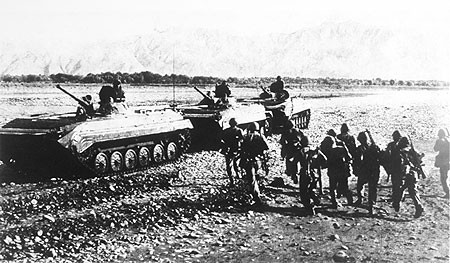The United States did not attack Afghanistan in the way the Soviet Union did in 1979. Instead, following the Soviet withdrawal in 1989 and the subsequent rise of the Taliban, the US provided support to various Afghan factions opposing the Taliban regime. However, after the September 11, 2001, terrorist attacks, the US launched a military operation in Afghanistan targeting Al-Qaeda and the Taliban who harbored them. This article will clarify the historical context leading to the US involvement in Afghanistan, focusing on the initial Soviet invasion and the US response in the late 1970s and early 1980s. Understanding this period is crucial to grasping the complexities of the later US intervention.
Soviet tanks in Afghanistan. This image illustrates the military presence of the USSR during the Soviet-Afghan War.
The Soviet Union’s invasion of Afghanistan in December 1979 was a pivotal moment in the Cold War. Moscow’s objective was to install a pro-Soviet regime and quell a growing insurgency against the communist government in Kabul. This action was met with international condemnation and prompted a strong response from the United States. The US viewed the invasion as a dangerous expansion of Soviet influence, potentially threatening vital oil supplies in the Middle East.
The roots of the conflict lay in the internal political instability of Afghanistan. A 1978 coup led by the pro-Soviet People’s Democratic Party of Afghanistan (PDPA) resulted in a communist government. However, internal divisions within the PDPA and a growing Islamic insurgency against the new regime destabilized the country. The Soviets, fearing the loss of a strategic ally and the potential spread of Islamic fundamentalism, decided to intervene militarily.
A map of Afghanistan. This illustrates the geopolitical significance of the country in relation to the Soviet Union and the Middle East.
Initially, the US response to the Soviet invasion focused on diplomatic pressure and economic sanctions. President Jimmy Carter condemned the Soviet action and imposed a grain embargo. The US also boycotted the 1980 Moscow Olympics. However, these measures did not deter the Soviets. The US then began providing covert support to the Afghan mujahideen, groups of Islamic fighters resisting the Soviet occupation. This support included funding, weapons, and training.
The Soviet invasion of Afghanistan marked a significant escalation of Cold War tensions. While the US did not directly attack Afghanistan at that time, it viewed the Soviet invasion as a threat to its strategic interests and responded by supporting the Afghan resistance. This period laid the groundwork for the later, more direct US involvement in Afghanistan following the 9/11 attacks. The initial US response focused on containing Soviet expansion and supporting the Afghan mujahideen in their fight against the Soviet occupation. This strategy ultimately contributed to the Soviet withdrawal from Afghanistan in 1989, but it also had long-term consequences that would shape the future of the region.
